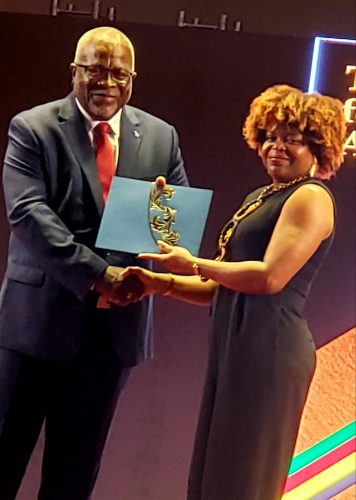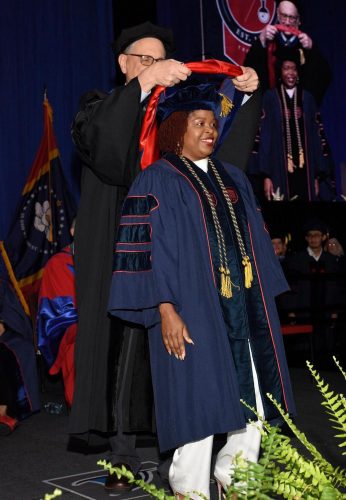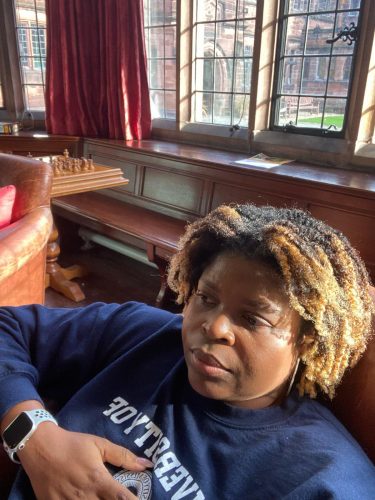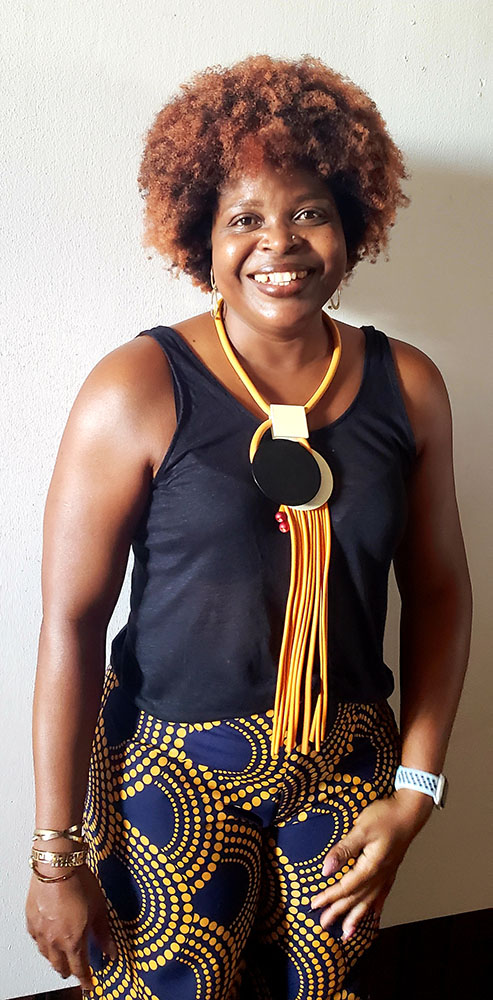Historian Dr Estherine Adams, whose manuscript, “The Few Among the Many: Women’s Labour in British Guiana’s Jails”, won the Non-Fiction Award in the 2024 Guyana Prize for Literature, is continuing to research and write with the aim of bringing clarity to some of the narratives that form part of Guyana’s colonial history.
One such narrative involves Reverend Richard Elliott, who was credited as one of the founders of the Presbyterian Church. Another highlights Swedish plantation and slave owners in British Guiana.
“Reverend Elliott, who came to British Guiana with a lot of missionaries, and who was attached to one of the Presbyterian churches on West Coast Demerara was accused of raping a number of enslaved young women. There was this big inquiry into his actions. It had to be something out of the norm and really bad for the authorities to launch an inquiry into what he was doing,” Adams told the Stabroek Weekend in an interview on Tuesday.

“Several young women were brave enough to come forward and accuse him of sexual impropriety with them. Nobody in those days really cared about enslaved women. The fact that they had an inquiry into it raised all kinds of red flags. That is one of the things I am working on; how we venerate these people who committed all these atrocities.
“This is living history in which we try to eliminate some things to get to the truth about the narratives that are pushed out there. A lot of these white missionaries who came down developed this white saviour kind of complex. You only hear the good things about them.”
Adams is working along with another colleague on this study which they are tentatively calling, ‘The Not So Very Right Reverend Richard Elliott’.

Her findings on Elliott and the involvement of “a lot of Swedish people owning plantations in Guyana,” she said, occurred during the time she spent at the Gladstone Library in Wales last year on a Miranda Kaufman Black British History Scholarship.
“A lot of the time we talk about the British, the French and the Dutch but we don’t talk about the Swedes who were involved in slavery,” she noted.
At Gladstone Library, she said, “The amount of stuff I gathered … was overwhelming. I basically gathered and gathered and when I came back I started sorting.”

Adams’s manuscript, “The Few Among the Many,” which spoke of women’s labour in jails during the post-emancipation period, had its genesis in research on British Guiana’s colonial penal system Adams undertook in 2015 with Professor Claire Anderson of the University of Leicester, who had obtained seed grant funding to conduct the research.
Prior to that, Anderson had researched the British penal system in the Andaman Islands and mention was made of the Mazaruni prison which piqued her interest. She subsequently met Dr Mellissa Ifill of the University of Guyana who encouraged her work.
“While I was researching that project, the data we were gathering spoke mainly about male prisoners. I kept seeing brief mentions of women,” Adams said.
The project was successful and Anderson obtained more funding for a larger project focused on mental health, neurological disorders and substance abuse in Guyana’s jails.
“Again I was a researcher on that project. Again while looking at all these prisons, I kept seeing little mention of women in Guyana’s prisons,” Adams said.
The establishment of the Fellowship Jail for women at Fellowship in the vicinity of the police station in Den Amstel on the West Coast Demerara, prior to the establishment of the New Amsterdam Women’s Prison, caught her attention.
“Initially only men were at Fellowship. Because of overcrowding at the Georgetown Prison, which initially housed men, women and juveniles, the authorities moved the men out of Fellowship Jail and put the women there making it the first prison for women in Guyana,” she stated.
Prior to this, except for Mazaruni Prison, she said, “Men and women were all housed in the jails at Mahaica, Suddie, Wakenaam and at Best on the West Coast where there was a temporary one.” Mahaica, New Amsterdam and Best jails were used exclusively for immigrant prisoners, she said.
British, prisoners built seawall
“I kept seeing a number of women in the prisons but no one was talking about them. The attention was focused on men because they were in the majority,” she said. “This is the reason for the title, ‘The Few Among the Many: Women’s Labour in British Guiana’s Jails’. The women’s experiences in the prison had an impact on the way in which the prison system evolved over time. I felt somebody had to talk about these women. Going through archival documents, encountering women by names and seeing what they were going through, resonated with me and it was a good opportunity for me to focus on that.”
Adams, who did both her bachelor’s and master’s degrees in history at UG, read for her doctorate in philosophy at the University of Mississippi where her study was on women in prisons in general.
When she started her research, she found that instead of women being used to keep the jails clean, cooking and the traditional work allotted to them, women prisoners in Guyana were sent to work on plantations that were close to the prisons and to work in public works programmes because most of the government agencies requested prison labour.
“The biggest surprise for me was the civil engineer requesting a large number of women to work on the sea defence system,” she said.
“Everything I am talking about here is post 1838, after emancipation into immigration. The immigrants, particularly the East Indians who were brought to British Guiana under contract, if they violated the contract, were subjected to either a fine or jail time. In most cases, the immigrants could not afford the fine and in some, they refused to pay the fine and were sent to prison,” she said.
In jail, the colonial authorities gave them hard labour.
The East Indian immigrants, in particular, were sent back to the plantations to work without pay. When their contracts were up, they would have to work back the time they were in jail for the planters before they were released.
“Most of the Creole or Black prisoners were sent to work on the seawall. Their labour was mostly used for the seawall you see out there. Of course, we all have this idea that the Dutch built the seawall using slave labour. That is not true. The Dutch built the mud dams and the dikes to keep the sea out,” Adams said.
In the 1940s during British rule, a massive flood that inundated government houses brought home to them the importance of having something more permanent.
“It was the British that built this modern granite sea defence system that you see here and not the Dutch,” she emphasised.
The prisoners at Mazaruni, she said, quarried the granite, which was taken to the convict depot at Kingston Seawall.
“They mainly used the prisoners from Mazaruni and Georgetown prisons to build the seawall. They are the ones who built the seawall. Finding out that was the biggest wow moment for me,” she stated.
Adams was fortunate to find in the National Archives, the civil engineer’s letters he wrote to the governors requesting them to send 50 or more women prisoners to work on the sea defence in Georgetown.
“I was also lucky to find daily reports for labour showing how many persons were incarcerated that day, where their labour was used, how many went to the race tracks, how many were hired out to the Mayor and City Council and how many went to the plantations. The majority during that period were sent to the seawall,” she added.
As a historian, she said, “I got to meet a lot of these wonderful women through their petitions and their journey in the jails. Many petitioned the governor to be released for whatever reason. There was a woman, the main breadwinner, who had about seven or eight children and who was concerned about what would happen to her children. There was a 14-year-old girl who was accused of killing a boy. Her story is so fascinating. It was quite a fascinating piece of research.”
Her research was her PhD dissertation. “I defended it. It was well accepted. My advisor said to me, ‘Estherine, you have your first book here.’ I said you have been with me for so long, maybe you are a little bit biased,” she recalled.
Submitting
Adams was a bit sceptical about submitting her dissertation on the women in the penal system in British Guiana post emancipation to the Guyana Prize for Literature.
“The work became so personal to me. It became like my baby. I was afraid to put it out there. I didn’t want to send it to publishers at large. I was only thinking of academic publishers, who can be brutal. I published a couple of academic articles and reviewer number two always gave you this brutal assessment,” she said.
On the deadline day for submissions, she was scrolling through Facebook when the notice appeared.
“I said this is probably a sign, let me do this. The judges were these highly acclaimed academics like Professor David Dabydeen. I said to myself, if this could get a third place or honourable mention or something, I know I am on the right track and I have something worth sharing. That was my thought process in submitting that to the Guyana Prize. The good thing is that they were accepting manuscripts and my work was, and is still in manuscript form,” she said.
Her dissertation required no revision and it was accepted on its first submission.
“I knew the dissertation was good but having it in a book manuscript format, I didn’t want to send it to a publisher for it to be rejected. The Guyana Prize for Literature became that first reviewer for this book manuscript. Now that it has passed this excellent panel of judges, I feel a lot more confident in submitting this to an academic publisher and getting some kind of feedback from them. The University of Guyana Press is one of those places that I want to submit my work for publishing and see what feedback I get from them,” she added.
Chair of the nonfiction category Professor Edward Greene said Adams’s submission was a well done piece of work. The judges were impressed with the documentation but noted there were areas where information was repeated. They said the arguments were strong.
Early beginnings
Adams is from Sixth Avenue, Bartica. She attended Mazaruni Primary School in the Mazaruni Prison Settlement where an aunt of hers taught.
“I was too young to start school and she took me with her. When I was entering primary four, the school which had been set up for the children of prison officers residing there, was closed down. That was how I wrote Common Entrance at St John the Baptist Primary and attended Anna Regina Multilateral on the Essequibo Coast where I lived in the dorms for five years,” she related.
After finishing school at 16 years old, she returned to Bartica and started teaching at Bartica Secondary at a time when there was a shortage of teachers at the school.
She taught accounts and business to fifth form students sending them up for the Caribbean Secondary Education Certificate examinations. “I was just out of high school with no training,” she recalled.
From Bartica Secondary she went to the Cyril Potter College of Education (CPCE) in 1996 where she completed the three-year secondary education programme majoring in social studies and English. “At CPCE, I was introduced to history. I was in that last batch of students to wear that brown uniform,” she said.
She recalled being blown away with the first history class by tutor Nebert Haynes on late 15th century Guyana. “She was so good, what you think a teacher should be. That was what captured me and I have remained with history ever since,” Adams said.
After graduating from CPCE she went back to teach at Bartica Secondary. In 2002, she returned to Georgetown to pursue a bachelor’s degree in history.
“I had some of the best professors in history,” she said. “We graduated in 2006 and Professor [Winston] McGowan was like, ‘Don’t spend too long away to do your master’s. When you take too much time away from studying you don’t want to come back.’”
She returned in 2007 to do the master’s programme during which time she taught at St Rose’s High until 2013.
As a social studies/history teacher she also travelled to the Caribbean Examinations Council headquarters in Jamaica to mark Caribbean Studies papers at the Caribbean Advanced Proficiency Examinations level for several years.
She joined the staff at UG in January 2014 as a lecturer I. she is now substantively a lecturer II and heads the Department of History and Caribbean Studies.
“We don’t have many history majors, but we have a lot of students doing history because we offer a lot of cross faculty courses. You can’t have all the sciences without the humanities. My professor used to say the scientist can hatch a dinosaur egg, but the historian can tell you why that is a bad idea. So history is important,” she posited.
For the 2024/2025 academic year, the department is working on merging some courses with the education department and offering some post-graduate courses in history.
“We have a lot of things we are trying to do to attract some numbers and expand our department,” she said.






